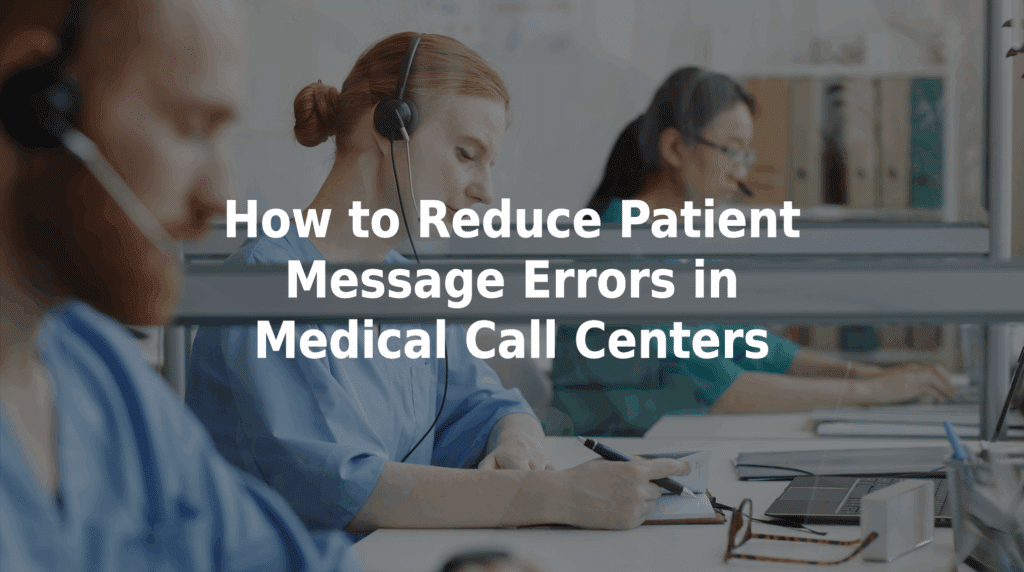How to Reduce Patient Message Errors in Medical Call Centers
Whether it’s a missed symptom, incomplete history, or a delayed request to the appropriate clinician, the consequences of inaccurate medical intake can impact patient safety, satisfaction, and health outcomes. Call centers need systems that ensure every message is logged correctly, escalated when needed, and stored in a secure, accessible format. Below, we explore how to reduce patient message errors in medical call centers.
Why Accurate Medical Message Intake Matters
Intake is the first link in the chain of patient care. When messages are misrecorded or delayed, it can lead to:
- Missed diagnoses or delayed treatments.
- Patient dissatisfaction and potential complaints.
- Increased liability for healthcare organizations.
- Workflow disruptions for clinical teams.
HIPAA Journal highlights how damaging communication failures can be, from one report detailing $1.7 billion in malpractice costs and 2,000 preventable deaths, to a study that found “80% of serious medical errors were the result of miscommunication between caregivers during patient handovers.”
Common Causes of Patient Message Errors
- Inconsistent Documentation Practices: Operators may not follow a standardized format for capturing messages, leading to incomplete or disorganized information.
- Lack of Real-Time Decision Support: Without prompts or guidance, nonclinical staff may misjudge which symptoms require escalation.
- Manual Data Entry Mistakes: Typos, misheard details, or system navigation issues can all lead to inaccurate messages.
- High Call Volumes and Time Pressure: Under stress, operators may rush through calls or skip important follow-up questions.
Best Practices to Improve Message Accuracy
To reduce patient message errors, call centers should implement the following.
- Standardized Message Templates: Use digital forms that require specific fields to be completed before submission.
- Automated Guidance Tools: Equip operators with AI-powered systems that prompt follow-up questions and highlight red flags.
- Regular Training and QA Reviews: Provide initial and ongoing training on message intake protocols, with routine quality assurance checks.
- Centralized Communication Platforms: Use a single, secure platform for managing and tracking all patient messages to avoid fragmentation.
Case Study: Vertigo or Stroke?
Consider the case of “Jane Doe,” a 72-year-old woman who called her doctor’s office at 7 PM on a Saturday. She told the answering service operator she was experiencing another bout of vertigo and needed a prescription refill. The operator recorded her request and sent it to the on-call nurse as a routine message.
At first glance, the issue seemed nonurgent. However, a nurse manager reviewing messages happened to notice the request and decided to follow up. During the call, she asked additional questions and discovered Jane was also experiencing a severe headache, dizziness, and right-arm weakness — symptoms that could indicate a stroke. The nurse manager immediately told Jane to hang up and call 911.
This near-miss highlights a critical issue in medical call centers: when message intake lacks context or symptom awareness, urgent conditions can be missed.
How TriageLogic’s MedMessage Automate Can Help
MedMessage Automate is an intelligent solution for helping patients submit accurate, complete explanations for the symptoms they’re experiencing. As an AI chatbot, it engages with patients through secure SMS links rather than phone calls. This self-service option guides them on how to describe their concerns in writing, then uses smart prompts to collect all necessary information before routing it securely to clinical staff.
This significantly improves intake accuracy, reduces operator burden, and increases speed to care — without compromising patient safety or compliance.
If you’re ready to reduce message errors, protect your patients, and streamline your call center operations, let’s talk.

